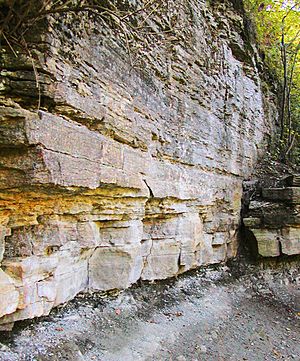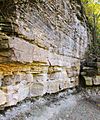River Warren Falls facts for kids

The River Warren Falls was a huge waterfall in what is now Saint Paul, Minnesota, United States. This amazing waterfall was about 2,700 feet (823 meters) wide and 175 feet (53 meters) tall! It was formed by a giant river that flowed after the last Ice Age.
Contents
How the Land Was Formed
The area where the Twin Cities (St. Paul and Minneapolis) are today has special layers of rock. Imagine a big sandwich of rock!
- The bottom layer is thick St. Peter Sandstone, about 155 feet (47 meters) deep.
- Above that is a thinner layer of shale, about 16 feet (5 meters) deep.
- On top is a hard layer of limestone, about 35 feet (11 meters) deep.
These rock layers formed about 500 million years ago. Back then, a warm sea covered this part of Minnesota. The hard limestone layer was made from the shells of ancient sea creatures.
About 20,000 years ago, a huge sheet of ice, called the Laurentide Ice Sheet, covered this area. As the ice melted and moved, it carved out deep valleys. Sometimes, huge chunks of ice would get buried and then melt, leaving behind big holes called kettles. These kettles later filled with water, creating many of the lakes we see in the Twin Cities today, like Lake Harriet and Bde Maka Ska.
The Mighty Glacial River Warren

About 11,700 years ago, a massive river started flowing. It was called the glacial River Warren. This river was formed from the melting of a huge ancient lake called Lake Agassiz. The River Warren was much bigger than any river we see today!
The River Warren carved a very wide valley through central Minnesota. The Minnesota River now flows in this ancient valley, but it's much smaller.
When the River Warren reached what is now St. Paul, its huge amount of water quickly washed away the loose dirt and rock. This created the amazing River Warren Falls, which plunged 175 feet (53 meters) into a deep gorge.
The powerful water at the base of the falls wore away the softer sandstone layer underneath. This caused the harder limestone layer on top to break off in big pieces. Because of this, the waterfall slowly moved upstream.
- By 10,000 years ago, the waterfall had moved to where the River Warren met the Mississippi River, near Fort Snelling.
- By 9,400 years ago, it had moved another two miles (3 km) upstream.
Around this time, Lake Agassiz found a new way to drain, flowing north towards Hudson Bay. So, the mighty River Warren stopped flowing. A much smaller river, the Minnesota River, took its place. This new river carried less sediment and filled in much of the deep gorge that the River Warren Falls had created.
In 1868, a general named G. K. Warren studied this huge valley. He was the first to explain how such a large river could have existed. Later, the ancient glacial river was named "River Warren" in his honor.
Minneapolis Waterfalls
As the River Warren Falls moved upstream, it passed the point where the much smaller Upper Mississippi River joined it. This created a new waterfall on the Mississippi River itself!
This new waterfall also started moving upstream on the Mississippi. It traveled about eight miles (13 km) over 9,600 years. In 1680, a famous explorer named Louis Hennepin saw it and named it St. Anthony Falls. This waterfall was very important because it provided power for mills, which helped the city of Minneapolis grow.
Today, you can still see a beautiful waterfall called Minnehaha Falls. It's a smaller version of the River Warren Falls. You can clearly see the hard limestone layer on top and the softer sandstone underneath, just like the big falls had. It's a great way to understand how these ancient waterfalls shaped the land!
Images for kids
-
Relief map showing glacial River Warren valley - flowing northwest to southeast, then northeast, then southeast. Falls were in present downtown St. Paul
-
Limestone cap over soft sandstone base as seen in Minnehaha Park



